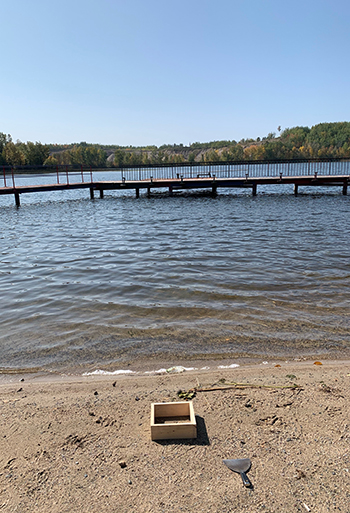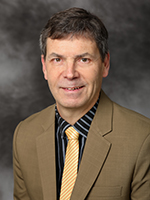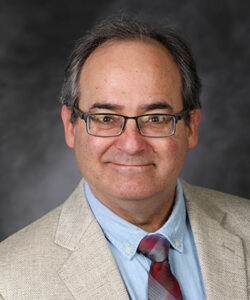UND student’s northern Minnesota beach study finds microplastic pollution
Minnesotans can still avoid the heavy microplastics load that mars many ocean beaches, Austin Siekkinen’s senior project suggests

The good news is, in a study that looked for microplastics by sifting shoebox-sized samples of sand from 20 northern Minnesota beaches, only one small bead of plastic was found.
The bad news is, one bead was, indeed, found.
This suggests that beaches in northern Minnesota remain relatively pristine, at least compared to their counterparts on America’s East and West coasts. But they’re no longer completely pristine — and Minnesotans who’d like their beaches to avoid the coastal beaches’ plastic-littered fates should take note.
That’s the conclusion of a unique study conducted last fall by a UND undergraduate in pursuit of a Bachelor of Science degree. For his senior project in environmental geosciences, Austin Siekkinen traveled to eight locations along the North Shore of Lake Superior, plus Cass Lake, Lake Bemidji, Side Lake and nine other beaches in northern Minnesota.

At each beach, he collected just over a quart of sand, taking care with his measurements and site selection (a half-meter from the water’s edge).
Then he came back with his neatly bagged samples to Grand Forks. At a soil lab, he dried, sifted and examined the samples, looking for plastic with, among other tools, a low-power microscope. As a final test, he submerged each sample in a bucket of water, looking for plastics that would float to the surface.
The result?
“After sieving through the 20 samples and looking at them under a microscope, only one piece of plastic was found,” Siekkinen wrote in his study. The bead (pictured above), which is about the size of a sesame seed and looks like a piece of Styrofoam, was found in the sand sample from the Lake Bemidji shoreline.
“Every year, 300 million tons of plastic is produced, and 8 million tons of that plastic is dumped into our oceans,” Siekkinen concludes.
“Based on this study, only minimal amounts of microplastic were found in the rivers and lakes of Northeastern Minnesota. … Northeastern Minnesotans still have a long way to go before they have to deal with high densities of microplastics that could cause problems for lakes within the region. However, now is the time to plan and act to eliminate this from ever becoming a problem.”
Reducing use, improving waste management and engineering safer plastics are among the remedies that society can pursue, Siekkinen said.
Why microplastics matter

Microplastics represent a special threat to the environment and are worth taking care to avoid, said Jaakko Putkonen, director of the Harold Hamm School of Geology and Geological Engineering at UND and Siekkinen’s thesis advisor.
“We’re all familiar with finding plastic and trash where it’s not supposed to be,” Putkonen said.
“But if you think about a big water bottle that somebody left behind, it’s unsightly, but it’s probably not going to cause much harm.
“Microplastics, in contrast, break up in nature into such small pieces that we often can’t even see them at all. This means they can get into the digestive systems of fish, other animals and eventually people as well, exposing us to the chemicals in some plastics that are known to be harmful.”
While a few researchers have looked for microplastics in Lake Superior’s surface waters and beach sand, Siekkinen’s is the first to extend that study to the state’s inland lakes and rivers, Putkonen said. “To our knowledge, nobody else has really looked for it in this part of the world. The fact that he found such a small amount suggests, ‘Hey, we’re still OK.’ But it’s still a very troubling subject, and we think it’s one that people might want to pay attention to.”

Siekkinen is from Hibbing, Minn., where hunting and fishing were a big part of his growing up. “So, I found a passion in outdoor life. And I want that to continue, with a safe environment for hunters and fishermen,” Siekkinen said.
That’s also why he majored in environmental geoscience, a field that studies not only the natural processes that have controlled Earth’s history, but the human activities that are affecting our planet today.
Growth at UND
“I loved my time at UND,” said Siekkinen, who graduated in December.
“I wouldn’t trade it for anything, and I encourage other kids to go there, too. I especially enjoyed dealing with the Geology department, where I found teachers like Jaakko who make the classwork and fieldwork so interesting.”
For his part, Putkonen says watching Siekkinen and students like him progress over their UND careers is a source of great satisfaction.
Most students who enter UND right out of high school are surprised by the rigor of college work. “But by the time they’re finishing up, as in Austin’s case, we just send them off to do field work on their own, and they can handle it,” Putkonen said.
“This work that Austin completed was a sizable project. But I didn’t have to be there to tell him what to do; if anything, he was prodding me: ‘Did you get a chance to look at that manuscript?’” Putkonen recalled with a laugh.
“It’s a huge growth that we see in these students. They enter as high-school students; they leave ready for a professional environment. And that is really the fun part, seeing how UND as an institution can make that difference.”



